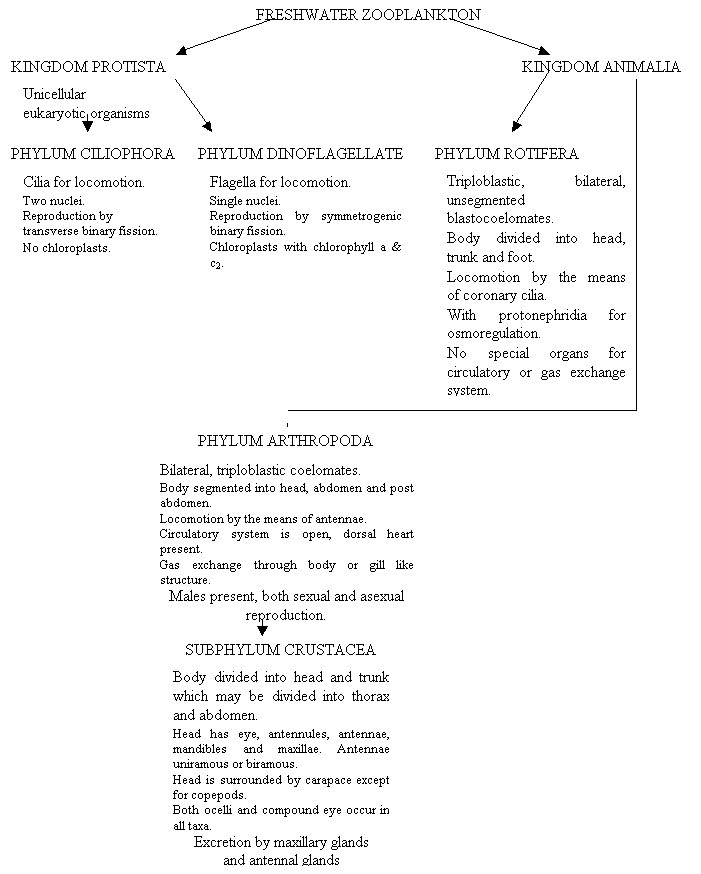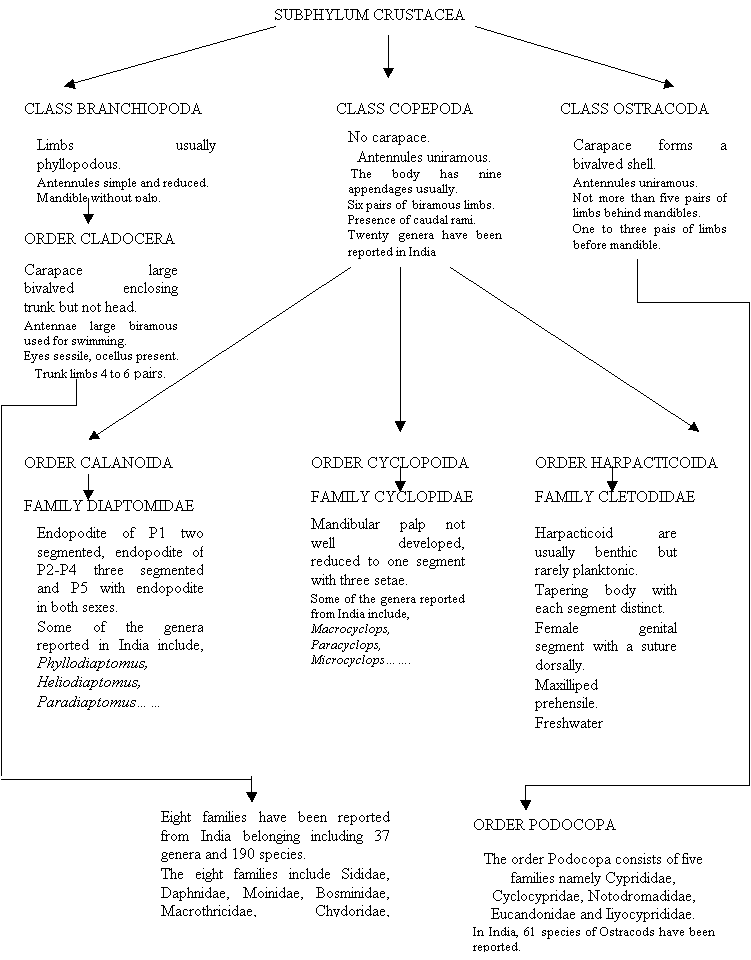
Appendix - 3 |

Figure 20: Schematic representation of Taxonomic classification of freshwater zooplankton.

TAXA |
ROTIFERA |
CLADOCERA |
COPEPODA |
OSTRACODA |
Kingdom |
Animalia |
Animalia |
Animalia |
Animalia |
| Phylum | Rotifera Triploblastic, bilateral, unsegmented blastocoelomates. Body divided into head, trunk and foot. Locomotion by the means of coronary cilia. With protonephridia for osmoregulation. No special organs for circulatory or gas exchange system. | Arthropoda Bilateral, triploblastic coelomates. Body segmented into head, abdomen and post abdomen. Locomotion by the means of antennae. Circulatory system is open, dorsal heart present. Gas exchange through body or gill like structure. Males present, both sexual and asexual reproduction. | Arthropoda Bilateral, triploblastic coelomates. Body segmented into head, abdomen and post abdomen. Locomotion by the means of antennae. Circulatory system is open, dorsal heart present. Gas exchange through body or gill like structure. Males present, both sexual and asexual reproduction. | Arthropoda Bilateral, triploblastic coelomates. Body segmented into head, abdomen and post abdomen. Locomotion by the means of antennae. Circulatory system is open, dorsal heart present. Gas exchange through body or gill like structure. Males present, both sexual and asexual reproduction. |
| Subphylum | - | Crustacea Body divided into head and trunk, which may be divided into thorax and abdomen. Head has eye, antennules, antennae, mandibles and maxillae. Antennae uniramous or biramous. Head is surrounded by carapace except for copepods. Both ocelli and compound eye occur in all taxa. Excretion by maxillary glands and antennal glands | Crustacea Body divided into head and trunk, which may be divided into thorax and abdomen. Head has eye, antennules, antennae, mandibles and maxillae. Antennae uniramous or biramous. Head is surrounded by carapace except for copepods. Both ocelli and compound eye occur in all taxa. Excretion by maxillary glands and antennal glands | Crustacea Body divided into head and trunk which may be divided into thorax and abdomen. Head has eye, antennules, antennae, mandibles and maxillae. Antennae uniramous or biramous. Head is surrounded by carapace except for copepods. Both ocelli and compound eye occur in all taxa. Excretion by maxillary glands and antennal glands |
| Class | Digononta Has paired ovaries No lorica or tubes Monogononta Lorica may be present or absent. Benthic, free swimming and sessile forms. Females with single ovary and a vitelarium. | Branchiopoda Limbs usually phyllopodous. Antennules simple and reduced. Mandible without palp. Maxillae reduced or absent. | Copepoda No carapace. Antennules uniramous. The body has nine appendages usually. Six pairs of biramous limbs. Presence of caudal rami. Twenty genera have been reported in India. | Ostracoda Carapace forms a bivalved shell. Antennules uniramous. Not more than five pairs of limbs behind mandibles. One to three pais of limbs before mandible. |
| Order | The class Digononta has 2 orders, namely Bdelloidea and Seisonidea , but both the orders are primarily benthic and epizoic forms. The class Monogononta has 3 orders namely Ploimida, Gnesiotrocha and Collothecaceae . | Cladocera Carapace large bivalved enclosing trunk but not head. Antennae large biramous used for swimming. Eyes sessile, ocellus present. Trunk limbs 4 to 6 pairs. | The copepoda has three orders namely Calanoida, Cyclopoida and Harpacticoida. | The Class Ostracoda has a order Podocopa The order Podocopa consists of five families namely Cyprididae, Cyclocypridae, Notodromadidae, Eucandonidae and Iiyocyprididae. In India, 61 species of Ostracods have been reported. |
| Family | There are 26 families reported in India . Epihanidae This family has 3 genus namely Epiphanes, Mikrocodides, Liliferotrocha Brachionidae This family has 5 genus namely Brchionus, Keratella, Plationus, Anuraeopsis Platyas,Notholca. Euchlanidae The family has 6 genus namely Euchlanis, Pseudoeuchlanis, Dipleuchlanis, Tripleuchlanis, Beauchampiella, Diplois Mytilinidae This family has 1 genus Mytilina which has 5 species Mytilina ventralis Mytilina ventralis brevispina Mytilina ventralis macracantha Mytilina mucronata Mytilina bisulcata Trichotridae The family supports 2 genus namely Trichotria, Macrochaetus Colurellidae The family has 3 genus – Colurella, Lepadella, Squatinella Lecanidae This family has the single largest genus Lecane among rotifera with 70 species. Proalidae This family has single genus with two species namely Proales decipiens Proales indirae Notommatidae The family is represented by five genus namely Cephalodella, Esophora, Notommata, Itura,Taphrocampa Scarididae The family has a single species namely Scaridium longicaudatum Linidae The family has a single genus Lindia Trichocercidae The family has a single genus with 21 species. Asplanchnidae The family has 4 genus Asplanchna, Asplanchnopus. The genus Asplanchna are predatory rotifers. Synchaetidae The family has 2 genus namely Polyarthra, Synchaeta with 6 and 5 species respectively. Gastropodidae The family has 2 genus Ascotrocha, Gastropus Dicranophoridae The family has single genus with 5 species namely Dicranophorus dolerus Dicranophorus tegillus Dicranophorus epicharis Dicranophorus forcipatus Dicranophorus lutkeni Order Gnesiotrocha The order has 6 families. Floscularidae The family has 5 genus – Limnias, Floscularia, Beauchampia, Lacinularia, Sinantherina Conochilidae The family has single genus with six species – Conochilus arboreus Conochilus dossuarius Conochilus hippocripis Conochilus madurai Conochilus natans Hexarthridae The family has 1 genus with four species – Hexarthra intermedia Hexarthra mira Hexarthra bulgaria Hexarthra fennica Filinidae The family has 1 genus with 5 species Filinia longiseta Filinia opoloensis Filinia pejleri Filinia cornuta Filinia terminalis Testudinellidae The family has 1 genus Testudinella with 6 species Trichosphaeridae The family has 1 species namely Horaella brehmi OrderCollothecaceae The order has 1 family Collothecidae The family has 2 genus with 4 species – Cupelopagis vorax Collotheca ornate Collotheca trilobata Collotheca mutabilis Order Bdelloida The order has 1 family with 18 species Philodinidae The family has 4 genus – Rotaria, Pseudoembata, Philodina Macrotrachela | About 8 families are reported in India Sididae Trunk and thoracic limbs covered by valves. Body length much greater than the height. Head clearly delimited. Antennae not branched. Bosminidae 5 to 6 pairs of thoracic limbs, dissimilar. Antennae fused with rostrum. Chydoridae Antennae not fused with rostrum. Dorsal and ventral rami of antennae three segmented. Daphnidae Dorsal ramus of antanne 3 and ventral ramus 4 segmented. Antennules immovable and short. Moinidae Antennae movable and mostly long. Antennules situated in the posterior side of the head. Macrothricidae Antennule in the anterior side of the head. Leptodoridae Trunk and thoracic limbs not covered by valves. Head elongated. Podonidae Trunk and thoracic limbs not covered by valves. Head short. Caudal appendage very short. | The order calanoida has a single family Diaptomidae Endopodite of P1 two segmented, endopodite of P2-P4 three segmented and P5 with endopodite in both sexes. Some of the genera reported in India include, Phyllodiaptomus, Heliodiaptomus, Paradiaptomus…… The order cyclopoida has a single family Cyclopidae Mandibular palp not well developed, reduced to one segment with three setae. Some of the genera reported from India include, Macrocyclops, Paracyclops, Microcyclops……. The order Harpacticoida has a single family Cletodidae Harpacticoid are usually benthic but rarely planktonic. Tapering body with each segment distinct. Female genital segment with a suture dorsally. Maxilliped prehensile. Freshwater planktonic species reported from India include Cletocampus albuquerquensis…… | The order Podocopa has five families – Cyprididae, Cyclocyprididae, Notodromadidae, Eucandonidae, Iilyocyprididae The family Cyprididae has 4 subfamilies namely Cypridinae, Cyprettinae, Stenocyprinae, Cypridosinae. The family Cyclocyprididae Has 1 species namely Physocypria fufuracea The family Notodromadidae has 2 genera – Centropypris, Indiacypris The family Eucandonidae has a single species Canadonopsis putealis The family Iilyocyprididae has single species – Ilyocypris nagamalaiensis |
| Genus | Sididae The family consists of 4 genus – Sida, Pseudosida, Latonopsis, Diaphanosoma, Daphnidae The family has 5 genus – Ceriodaphnia, Daphnia, Daphniopsis, Scapholeberis Simocephalus Moinidae The family has 2 genus – Moina, Moinodaphnia Bosminidae The family has 2 genera – Bosmina, Bosminopsis Macrothricidae The family has 4 genus – Macrothrix, Echinisca, Streblocerus, Ilyocrptus. Chydoridae This family has two subfamily Eurycercinae, Aloninae Eurycercinae The subfamily has 4 genus – Eurycercus, Pleuroxus Alonella, Chydorus. Aloninae The subfamily has 10 genus – Alona, Acroperus, Camptocerus, Graptoleberis, Leydigia, Biapertura, Oxyurella, Kurzia, Euryalona, Indialona. Leptodoridae This family has a single genus Leptodora |